
- •Граматичні відомості
- •Граматичні відомості Визначники іменника, артиклі
- •Прикметник
- •Inside cockpit
- •Module 2. ElectricIty
- •Inductor
- •Vacuum tube
- •Граматичні відомості
- •Граматичні відомості
- •Паралельні структури
- •It has been shown that most of the patients improved noticeably.
- •Code of Ethics
- •Is there any risk for computer users?
- •Граматичні відомості
- •Main activities in metrology
- •International System of Units
- •Module 7. Analog and digital instruments
- •Voltmeter circuit.
- •Errors in Measuring Instruments
- •1) Assembly Errors
- •2) Environmental Errors
- •3) Random Errors
- •Module 8. Information and measurement systems in aviation
- •Very High Frequency Omni-directional Range (vor)
- •Module 9. Introduction to academic English writing
- •Acceptance Letters How to write an acceptance letter: Even if you have accepted verbally, it is smart to write an acceptance letter to formally accept the offer and to confirm the details.
- •How to write an effective claim letter in minutes:
- •Request Letters
- •How to write a request letter to help you to get what you want:
- •Example Request Letter
- •Arrowhead Conference Center
- •412 Bellevue Lane Brewster, Maryland
- •Curriculum vitae
- •Careers guidance questionnaire
- •Professional english Measurement and engineering
Code of Ethics
“An essential feature of a profession is the acceptance by its members of a code that outlines desirable behavior and specifics obligations of members to each other and to the public. Such a code derives from a desire to maximize perceived benefits to society and to the profession as a whole and to limit actions that might serve the narrow self-interests of individuals. The advancement of science requires the sharing of knowledge between individuals, even though doing so may sometimes entail foregoing some immediate personal advantage.”
Exercise. Answer the following questions.
1) What does a code of ethics outline and specify?
2) A code of ethics states obligations to two groups of people. Who are they?
3) A code of ethics should benefit two groups. What groups are they?
4) What should a code of ethics prevent?
5) What is needed to order for science to make advances? (a three-word phrase)
Вправи для самостійної роботи
Exercise 1. Translate the text in written form. Be ready to discuss the contents during next lesson.
Is there any risk for computer users?
Researchers have begun to worry about the health risks of spending a lot of time in front of a computer. Anyone spending more than four hours a day working on a PC may start to suffer from aching hands, neck or shoulders, occasional headaches and eye strain. These can all make you feel irritable and stressed. Is there anything we can do to avoid these risks?
There’s quite a lot one can do. For example, if you take the trouble to position your computer property you can avoid backache. Get a good chair—one that supports your lower back and is adjustable so you can have both your feet on the floor. Position the keyboard at the same height as your elbows, with your arms parallel to the work surface, and position the monitor so it is at of just below eye level. You should look down at it slightly, not up. Don’t put your monitor in front of a window, and make sure that there isn’t a lamp shining directly into your eyes or reflecting off the screen. The monitor should also be fitted with a tilt-and-swivel stand. It’s a kind of stand that lets you move the monitor up or around so you can use it at the right angle and height. If your eyes fell really sore, don’t use a monitor that’s fuzzy or that distorts the image give your eyes a rest—look away from the monitor from time to time, out of the window or across the room.
All monitors, except LCD displays, emit extremely low frequency radiation. We don’t really know how serious prolonged exposure to this radiation can be but recent results are not very hopeful. To minimize your risk, stay at arm’s length away from the front of the monitor when you’re working. If you work in a room with a lot of computers, make sure you sit at least 1 m 20 cm away from the sides or backs of any monitors as the radiation fields can be strong there.
As you know, they’re projective filters that fit over the front of the monitor. They can’t absorb all the ELF radiation but they do reduce it substantially. Anyway, the effects of radiation from screens are still being studied, so don’t get too alarmed.
occasional strain |
нечастий, випадковий напруження |
adjustable elbow |
регульований лікоть |
Exercise 2. Mach the words and phrases with their definitions.
in series electric circuit voltage drop in parallel equation terminal to be distributed |
the complete circle that an electric current travels a statement that show that totals are equal being connected one after another to be shared among the group point of wire connection being connected to have separate paths reduction in amount of potential difference |
Exercise 3. Scan the text from pages 238-239 and find out combinations of two successive nouns. Translate the meaning of these combinations.
Example: potential difference – різниця потенціалів.
Lesson 2
ВИВЧЕННЯ ТЕРМІНОЛОГІЇ ЗА ТЕМОЮ МОДУЛЯ
Exercise 1. Learn the text, be ready to answer the teacher’s questions.
Kirchhoff’s laws
There are a number of ways to determine the currents and voltage drops in DC networks. One of them, the Ohm’s law, was discussed before (Lesson 1). For complex multi-loop circuits Kirchhoff’s laws are applied.
Kirchhoff’s laws state:
Current Law. At any junction in an electric circuit the total current flowing towards that junction is equal to the total current flowing away from the junction (node), i.e.
 .
.
Thus, referring to Figure 32:

Fig. 32. Illustration for Voltage Law.
I1 + I2 = I3 + I4 + I5 or I1+I2 – I3 –I4 – I5 = 0
Voltage Law. In any closed loop in a network, the algebraic sum of the voltage drops (i.e. products of current and resistance) taken around the loop is equal to the resultant e.m.f. acting in that loop.
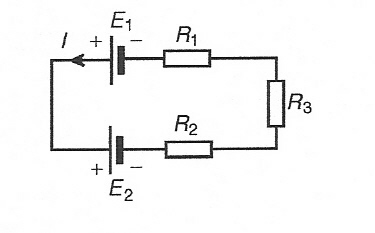
Fig. 33. Illustration for Current Law.
Thus, referring to Figure 33: E1 – E2 = IR1 + IR2 + IR3 (Note that if current flows away from the positive terminal of a source, that source is considered by convention to be positive. Thus moving anticlockwise around the loop of Figure 33, E1 is positive and E2 is negative.)
Example. Use Kirchhoff’s laws to determine the currents flowing in each branch of the network shown in Figure 34a.
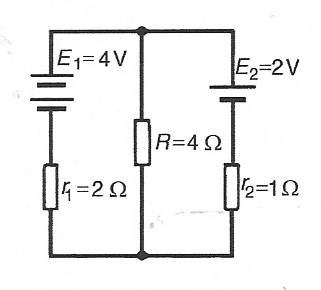
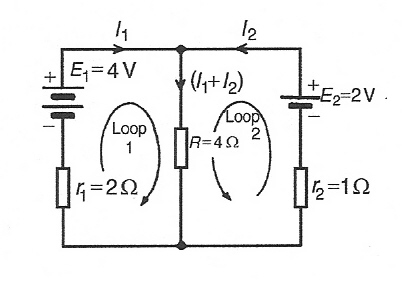
a b
Fig. 34. Example of Kirchhoff’s laws application.
Procedure
1 Use Kirchhoff’s current law and label current directions on the original circuit diagram. The directions chosen are arbitrary, but it is usual, as a starting point, to assume that current flows from the positive terminals of the batteries. This is shown in Figure 34b where the three branch currents are expressed in terms of I1 and I2 only, since the current through R is I1 + I2.
2 Divide the circuit into two loops and apply Kirchhoff’s voltage law to each. From loop 1 of Figure 34b, and moving in a clockwise direction DC circuit theory as indicated (the direction chosen does not matter), gives E1 = I1r1 + (I1 + I2)R, i.e. 4 = 2I1 + 4(I1 + I2),
i.e. 6I1 + 4I2 = 4 (1)
From loop 2 of Figure 34b, and moving in an anticlockwise direction as indicated (once again, the choice of direction does not matter; it does not have to be in the same direction as that chosen for the first loop), gives:
E2 = I2r2 + (I1 + I2)R, i.e. 2 = I2 + 4(I1 + I2),
i.e. 4I1 + 5I2 = 2 (2)
3 Solve equations (1) and (2) for I1 and I2.
2 x (1) gives: 12I1 + 8I2 = 8 (3)
3 x (2) gives: 12I1 + 15I2 = 6 (4)
(3)
– (4) gives: 7I2
= 2 hence I2
=
![]() –0.286
A
–0.286
A
(i.e. I2 is flowing in the opposite direction to that shown in Figure 13.3b.)
From (1) 6I1 + 4(– 0.286) = 4
6I1 = 4 + 1.144
Hence
I1
=
![]() = 0.857
A
= 0.857
A
Current flowing through resistance R is
I1 + I2 = 0.857 + (– 0.286) = 0.571 A
Exercise 2. Work in a small group of 2-3 students. Draw a simple circuit with no more than 3 nodes. Apply Kirchhoff’s laws to calculate voltages and currents in any point of the circuit. Be ready to present the results of calculations at the blackboard.
Exercise 3. Find in the text English equivalents to the following words and word combinations.
Багатоконтурне коло, вузол (з’єднання), добуток, рухатись за/проти годинникової стрілки, відмічений напрямок струму, обраний напрямок, рухатись у зворотному напрямку, струм що витікає, довільно обраний напрямок.
Граматичні відомості
Підрядні речення, що виконують функцію прислівника (adverb clauses)
Підрядні речення-прислівники відповідають на запитання, що притаманні різним видам прислівника і виконують їх функції:
We saw several new plays when we were in San Francisco.
Подібно до прислівників, підрядні речення цього типу розрізняються за видами (часу, місця, причини та ін.). Всі вони починаються зі сполучникового слова, такого як ‘when’ у попередньому прикладі. У таблиці 15 наведені найбільш поширені види підрядних речень-прислівників та приклади відповідних сполучників.
Таблиця 15
Види підрядних речень-прислівників
Type of adverb clause |
Conjunctions |
Time Her mother died when she was young. |
after by the time (that) before once when as/so long as as soon as whenever since every time (that) |
Condition If I were you, I wouldn’t do it. |
unless whether or not if in case only if in the event that |
Cause and effect I couldn’t refuse because I liked her. |
because now/so that since |
Concessive (contrast) I used to read a lot although I didn’t get much time. |
although even though while |
Direct contrast Tom is reach, while Ann is poor. |
while whereas |
Place He went where the doctor sent him. |
where wherever |
Manner You ought to read as he does. |
as as if/though that |
Подібно до підрядних речень типу іменника та прикметника, підрядні речення-прислівники є залежними і не можуть використовуватись самостійно. Якщо підрядне речення стоїть після головного, на відміну від українського речення, кома між частинами складного речення зазвичай не ставиться, але кома потрібна, якщо речення починається з підрядної частини (приклад з умовним реченням).
Вираження майбутнього в підрядних реченнях часу
Складнопідрядні речення часу за будовою суттєво відрізняються від відповідних українських речень: якщо підрядна частина стосується майбутнього часу, присудок підрядного речення має форму теперішнього часу, такі форми майбутнього часу англійської мови, як ‘will/shall’ або ‘be going to’ у цьому випадку не використовуються:
Before Gina leaves, she is going to finish her work.– До того, як Джина поїде (майбутній час на відміну від leaves у теперішньому часі), вона збирається закінчити роботу.
I shall go to the cinema when he comes.
Інколи у підрядній частині для вираження активності в конкретний час у майбутньому використовується форма present progressive:
While I am passing my test tomorrow, please don’t call me.
Часом у підрядній частині використовується форма present perfect, щоби підкреслити завершення дії до певного часу або події у майбутньому:
I’ll take a vacation after I have finished my paper on computer technologies.
Exercise 1. Combine each pair of sentences punctuating appropriately and omitting unnecessary words. Use the given time words only if this is possible. Underline subordinate clause.
I turned off the computer. Then I went to bed.
a. before b. by the time c. after
I saw Rome’s Colosseum. I was speechless.
a. until b. the first time c. before
I stood up to give my speech. Immediately before that, I got butterflies in my stomach.
a. until b. while c. just before
Peter can leave to his parents. He is going to pass his exam.
a. after b. as soon as c. when
Alex saw the fire. After that he called the fire department.
a. before b. while c. as soon as
At first Tony had not wanted to have children. Then his beloved daughter was born.
a. after b. until c. when
7) I left my home town ten years ago. After that I have returned to visit my family and friends many times.
a. as soon as b. when c. since
Exercise 2. Complete the sentences with proper punctuation. Pay attention to correct usage of verb tenses.
Since I installed a new password …
By the time I finish the test …
I have been studying this course for two years. When I finish it …
I had already finished my work …
… as long as I live.
Once spring comes …
Not long after he …
My roommate get nervous every time …
I will be here …
The last time I …
Комунікативна практика
Discuss with your group mates and the teacher the problem of possible harm may be caused to users by computer equipment (use the article ‘Is there any risk for computer users?’ from page 246.
What is your own opinion about how serious is the problem? Why do you think some users put cactuses nearby their working places? How effective is this remedy?
Вправи для самостійної роботи
Exercise 1. Translate the following text into Ukrainian (Russian) and then answer the question.
Resistance and resistivity
The resistance of an electrical conductor depends on 4 factors, these being: (a) the length of the conductor, (b) the cross-sectional area of the conductor, (c) the type of material and (d) the temperature of the material.
Resistance, R, is directly proportional to length, l, of a conductor, i.e. R = α1l. Thus, for example, if the length of a piece of wire is doubled, then the resistance is doubled.
Resistance is inversely proportional to cross-sectional area, a, of a conductor, i.e. R = α21/a. Thus, for example, if the cross-sectional area of a piece of wire is doubled then the resistance is halved.
Since R = α1l and R = α21/a then R = ρl/a. The constant of proportionality ρ ((Greek rho) in the equation is known as the resistivity of the material and allows to take into account the type of material used.
Thus,
resistance
R =
![]() ohms
ohms
ρ is measured in ohm meters (Ωm).
The value of the resistivity is that resistance of a unit cube of the material measured between opposite faces of the cube.
In general, as the temperature of a material increases, most conductor coefficients of resistance increase in resistance, insulators decrease in resistance, whilst the resistance of some special alloys remain almost constant. The temperature coefficient of resistance of a material is the increase in the resistance of a 1Ω resistor of that material when it is subjected to a rise of temperature of 1°C. The symbol used for the temperature coefficient of resistance is α (Greek alpha). Thus, if some copper wire of resistance 1Ω is heated through 1°C and its resistance is then measured as 1.0043Ω then α = 0.0043Ω/Ω°C for copper. The units are usually expressed only as ‘per C’, i.e., α = 0.0043/°C for copper. If the 1Ω resistor of copper is heated through 100°C then the resistance at 100°C would be 1 + 100 x 0.0043 = 1.43 Ω.
Question: How does resistance of a wire depend on its diameter?
Exercise 2. Learn again the text on pages 244-245 and then complete the sentences.
In any node the total current flowing towards that node is equal to …
The sum of the emfs in any closed loop is equivalent to the sum of…
… of currents in a network of conductors meeting at a point is zero.
Lesson 3
ВИВЧЕННЯ ТЕРМІНОЛОГІЇ ЗА ТЕМОЮ МОДУЛЯ
Exercise 1. Learn the text an answer the questions.
Alternating voltages and currents
Electricity is produced by generators at power stations and then distributed by a vast network of transmission lines (called the National Grid system) to industry and for domestic use. It is easier and cheaper to generate alternating current (AC) than direct current (DC) and AC is more conveniently distributed than AC since its voltage can be readily altered using transformers. Whenever DC is needed in preference to AC, devices called rectifiers are used for conversion.
L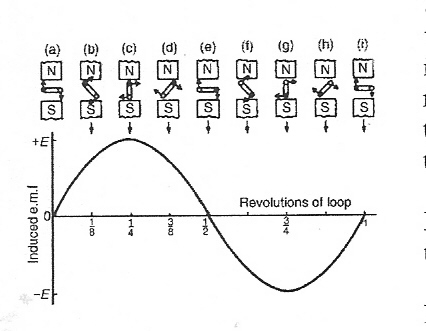 et
a single turn coil be free to rotate at constant angular velocity
symmetrically between the poles of a magnet system as shown in Figure
35.
et
a single turn coil be free to rotate at constant angular velocity
symmetrically between the poles of a magnet system as shown in Figure
35.
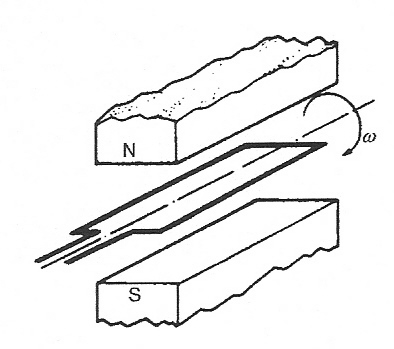
Fig. 35. Generation of ac current.
An e.m.f. is generated in the coil (from Faraday’s Laws) which varies in magnitude and reverses its direction at regular intervals. The reason for this is shown in Figure 35. In positions (a), (e) and (i) the conductors of the loop are effectively moving along the magnetic field, no flux is cut and hence no e.m.f. is induced. In position (c) maximum flux is cut and hence maximum e.m.f. is induced. In position (g), maximum flux is cut and hence maximum e.m.f. is again induced. However, using Fleming’s right-hand rule, the induced e.m.f. is in the opposite direction to that in position (c) and is thus shown as E. In positions (b), (d), (f) and (h) some flux is cut and hence some e.m.f. is induced. If all such positions of the coil are considered, in one revolution of the coil, one cycle of alternating e.m.f. is produced as shown. This is the principle of operation of the ac generator (i.e. the alternator).
Waveforms
If values of quantities which vary with time t are plotted to a base of time, the resulting graph is called a waveform. Some typical waveforms are shown in Figure 36.
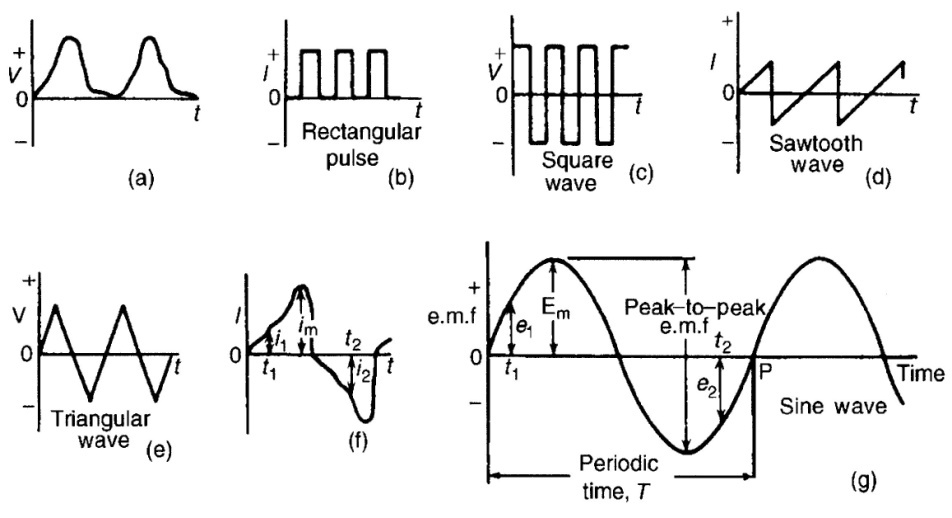 Fig.
36. Waveforms of AC.
Fig.
36. Waveforms of AC.
Waveforms (a) and (b) are unidirectional waveforms, for, although they vary considerably with time, they flow in one direction only (i.e. they do not cross the time axis and become negative). Waveforms (c) to (g) are called alternating waveforms since their quantities are continually changing in direction (i.e. alternately posi- tive and negative). A waveform of the type shown in Figure 36 (g) is called a sine wave. It is the shape of the waveform of e.m.f. produced by an alternator and thus the mains electricity supply is of ‘sinusoidal’ form. One complete series of values is called a cycle (i.e. from O to P in Figure 36 (g)).
The time taken for an alternating quantity to complete one cycle is called the period or the periodic time, T, of the waveform. The number of cycles completed in one second is called the frequency, f, of the supply and is measured in hertz, Hz. The standard frequency of the electricity supply in Great Britain is 50 Hz.
-
e.m.f. (electromagnetic force)
magnetic flux
rectifier
revolution
single turn coil
transformer
to induce
е.р.с. (рос. ЭДС)
магнітний потік
випрямляч
оберт
одновиткова котушка
трансформатор
індукувати
The common waveform of industrial current is a simple sine wave. Where the other forms plotted in Figure 36 may be found?
Explain the names of waveforms presented in the Figure. Find a name for the form f.
What can be used for mutual conversion of ac and dc? When such conversion may be needed?
What is an Ukrainian equivalent for Fleming’s right-hand rule?
Exercise 2. Use these words and their combinations to make sentences:
Waveform, rectifier, e.m.f., alternator, angular velocity, magnetic flux, sinusoidal.
Граматичні відомості
Підрядні речення причини та наслідку (adverb clauses to show cause and effect)
Речення цього типу пояснюють причину події, про яку йдеться в головному реченні:
He bought a new home because he got a better job.
У цих реченнях дотримаємось таких самих правил пунктуації, як в розглянутих раніше реченнях часу: кома в англійському реченні ставиться лише тоді, коли підрядне речення йде перед головним.
Since a Monday is a holiday, we needn’t go to work.
Значення слова ‘since’ у таких реченнях відповідає українським словам ‘тому що’, ‘оскільки’ і визначає логічний взаємозв’язок між подіями. Такі фрази близькі за формою до формул математичної логіки:
Given the fact that X is true, Y is the result.
Слід зазначити, що слово ‘since’ може також означати період часу (з тих пір):
She left London ten years ago, and I haven't seen her since.
Для позначення причинно-наслідкового зв’язку можуть також використовуватись такі слова і фразі, як ‘as’, ‘now that’, ‘due to’, ‘due to the fact’, тощо:
The court of inquiry ruled that the crash was due to pilot error.
As long as you have the time, why don't you come for dinner?
Такі фрази, як ‘due to the fact (that)’, ‘owing to the fact (that)’ зазвичай мають дуже формальний характер:
The school's poor exam record is largely due to the fact that it is chronically underfunded.
‘Now that’ еквівалентно фразі ‘because now’ (тому що зараз) і позначає причини теперішніх та майбутніх подій:
I'm going to relax now that the school year is over. – Я збираюсь відпочити, тому що шкільний рік уже закінчився.
Exercise 1. Combine the sentences using the words in parentheses. Add commas if necessary.
Cold air hovers near the sea. It is heavier than hot air. (as)
You've done such a good job. I'm giving everyone a 10% bonus. (because)
Do you want to go for a picnic? The rain has stopped. (now that)
You paid for dinner last time. Please let me pay for it now. (since)
We will be staying for an extra week. We haven not finished yet. (due to the fact that)
He was sleepy. He went to bed. (because)
I’m going to relax. The classes are over. (now)
Exercise 2. Complete the sentences with appropriate ending.
Since the computer is too slow to…
The driver didn’t … because …
As we don’t have class tomorrow …
Given the fact that the earth is round …
Since it is too expensive to …
Make up your own sentences showing cause and effect.
Комунікативна практика
Making offers and suggestions
When transforming offers and suggestions into indirect speech, we use the verb ‘to offer’ and ‘to suggest’. There is a difference between these two verbs, though both are translated in Ukrainian as ‘запропонувати’. The person who makes an offer intends to do the action himself, and the action is the act of kindness. A suggestion may also be an act of kindness, but not necessarily; the person who makes a suggestion may or may not intend to do the action himself.
For example:
He said to her, “Shall I bring a glass of water?” She said, “Do, please”—direct speech.
He offered to bring her a glass of water and she accepted the offer—indirect speech.
BUT
He said to her, “Suppose we go there together?” She said, “Very well”—direct speech.
He suggested they should go there together and she agreed—indirect speech.
Sentences expressing advice are converted into indirect speech by means of the verb ‘advise’.
He said to them, ‘You’d better take a taxi, you may be late.”—direct speech.
He advised to take a taxi, as otherwise they might be late.—indirect speech.
Exercise. Make up your own sentences which express different kinds of offers and suggestions. Work in pairs and make up a dialogue using these examples.
Вправи для самостійної роботи
Exercise 1. Translate the following text in written.
AC values
Instantaneous values are the values of the alternating quantities at any instant of time. They are represented by small letters, i, v, e etc., (see Figures 14.3(f) and (g)). The largest value reached in a half cycle is called the peak value or the maximum value or the crest value or the amplitude of the waveform. Such values are represented by Vm, Im, etc. (see Figures 14.3(f) and (g)). A peak-to-peak value of e.m.f. is shown in Figure 14.3(g) and is the difference between the maximum and minimum values in a cycle.
The average or mean value of a symmetrical alternating quantity, (such as a sine wave), is the average value measured over a half cycle, (since over a complete cycle the average value is zero).
Average or mean value = area under the curve / length of base
The area under the curve is found by approximate methods such as the trapezoidal rule, the mid-ordinate rule or Simpson’s rule. Average values are represented by VAV, IAV , etc.
For a sine wave, average value = 0.637 x maximum value (i.e. 2/π x maximum value)
The effective value of an alternating current is that current which will produce the same heating effect as an equivalent direct current. The effective value is called the root mean square (rms) value and whenever an alternating quantity is given, it is assumed to be the rms value. For example, the domestic mains supply in Great Britain is 240 V and is assumed to mean ‘240 V rms’. The symbols used for rms values are I, V, E, etc. For a non-sinusoidal waveform as shown in Figure 14.4 the rms value is given by:
![]()
where n is the number of intervals used.
For a sine wave, rms value = 0.707 x maximum value
(i.e. 1/√2 x maximum value)
Form factor = rms value / average value.
For a sine wave, form factor = 1.11.
Peak factor = maximum value / rms value
For a sine wave, peak factor = 1.41.
The values of form and peak factors give an indication of the shape of waveforms.
Exercise 2. Complete the sentences.
A waveform of common industrial power supply may be represented …
Unidirectional wave forms never cross …
Although industrial current is distributed in a form of ac, whenever dc is needed …
The frequency of ac is …
The standard frequencies of ac in Great Britain and Ukraine …
Exercise 3. Translate sentences. Pay attention to the verb to take.
When messages are sent along the Internet, they are broken up into small “packets” that take different routes to get to the destination.
When selecting firewalls, the following considerations should be taken into account.
But when steps are taken to hide the sequence the result can have significant strength.
Typically, a ciphertext is deciphered under different keys until plaintext is recognised. On average, this may take about half as many decipherings as there are keys.
Typically these take the form of iterative applications of fairly simple computations.
Involution is a cipher which takes plaintext to ciphertext and ciphertext back to plaintext, using the exact same operation.
Lesson 4
ВИВЧЕННЯ ТЕРМІНОЛОГІЇ ЗА ТЕМОЮ МОДУЛЯ
Exercise 1. Learn the text an then answer the questions.
Single-phase series AC circuits
Purely resistive AC circuit
In a purely resistive AC circuit, the current IR and applied voltage VR are in phase. See Figure 37.
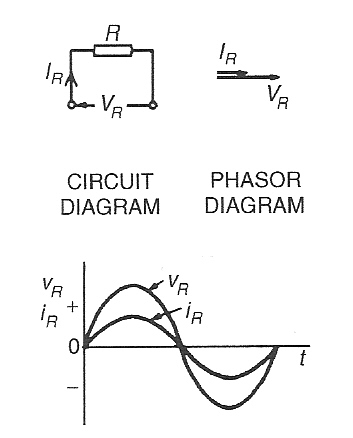
Fig. 37. Current and voltage waveforms
in a purely resistive ac circuit.
Purely inductive AC circuit
In a purely inductive AC circuit, the current IL lags the applied voltage VL by 90° (i.e. π/2 rads). See Figure 38. In a purely inductive circuit the opposition to the flow of alternating current is called the inductive reactance, XL
XL = VL/IL=2πfLΩ
where f is the supply frequency, in hertz, and L is the inductance, in henrys. XL is proportional to f as shown in Figure 38.
Purely capacitive AC circuit
In a purely capacitive AC circuit, the current IC leads the applied voltage VC by 90° (i.e. π /2 rads). See Figure 39.
In a purely capacitive circuit the opposition to the flow of alternating current is called the capacitive reactance, XC
XC
=![]() =
=
![]() Ω
Ω
where C is the capacitance in farads.
XC varies with frequency f as shown in Figure 39.
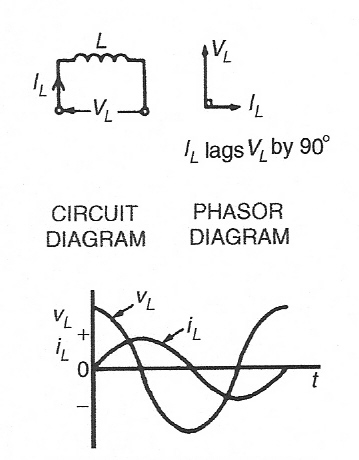
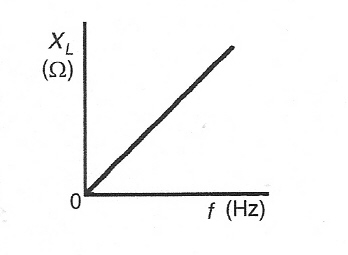
Fig. 38. Current and voltage waveforms in a purely inductive AC circuit.
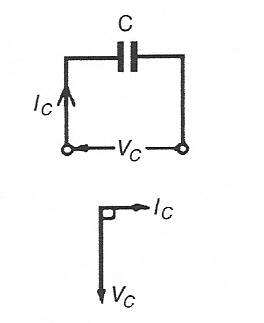

Fig. 39. Current and voltage waveforms in a purely capacitive AC circuit.
R –L– C series AC circuit
In an AC series circuit containing resistance R, inductance L and capacitance C, the applied voltage V is the phasor sum of VR, VL and VC (see Figure 40). VL and VC are anti-phase, i.e. displaced by 180°, and there are three phasor diagrams possible—each depending on the relative values of VL and VC
When XL >XC (Figure 40 (b): Z = √[R2 + (XL – XC)2]
and tanφ = (XL – XC)/R
When XC >XL (Figure 40 (c): Z = √[R2 + (XC – XL)2 ]
and tanα = (XL – XC)/R
W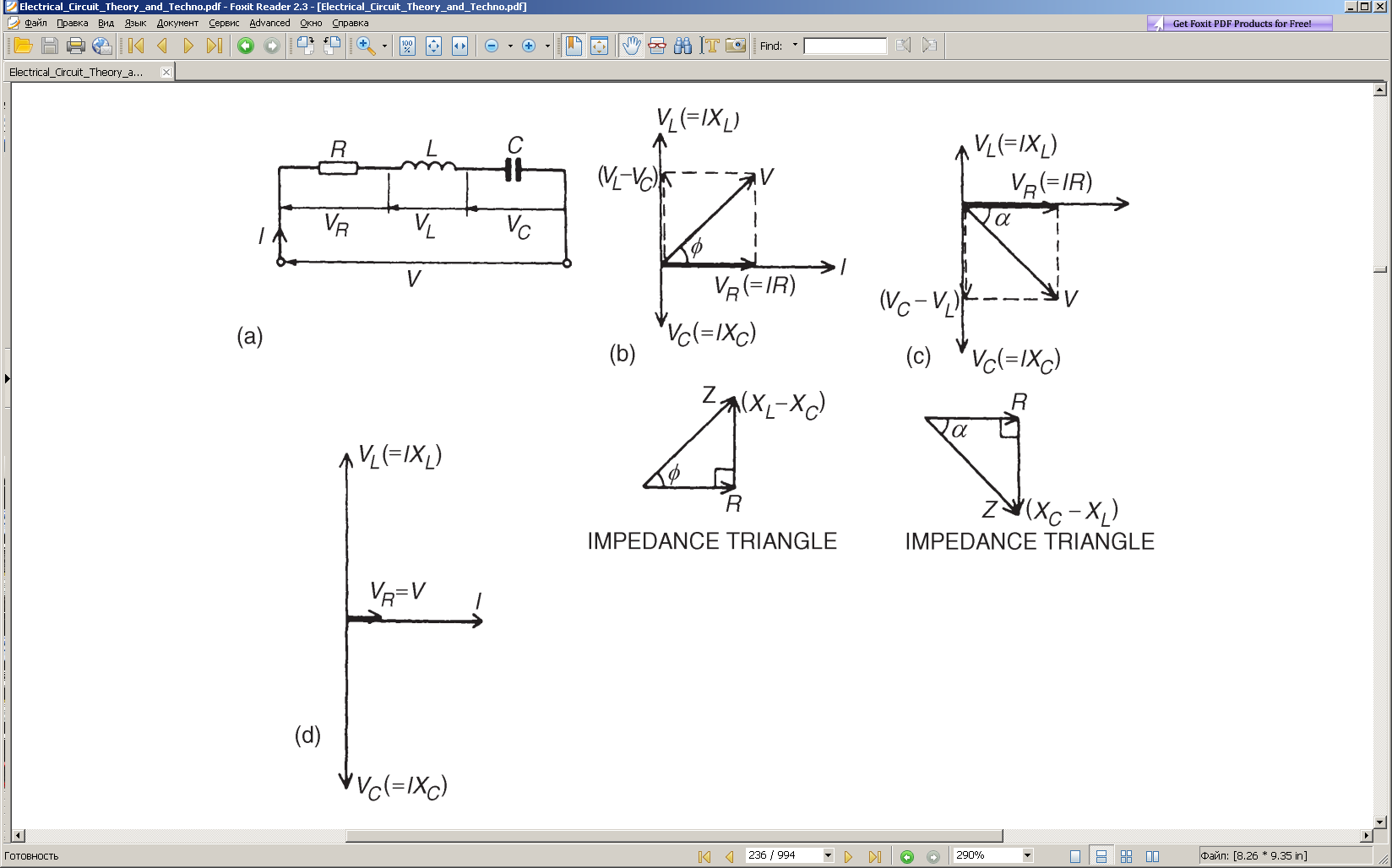 hen
XL = XC
(Figure 40 (d)), the applied voltage V
and the current I
are
in phase. This effect is called series resonance.
hen
XL = XC
(Figure 40 (d)), the applied voltage V
and the current I
are
in phase. This effect is called series resonance.
Fig. 40. Current and voltage waveforms in a RLC AC circuit.
-
to lag
to lead
reactance
capacitive
inductive
відставати
випереджати
реактивність
ємкісний
індуктивний
How different are current and voltage waveforms in resistive, inductive and capacitive ac circuits?
Under what conditions are current and voltage in phase?
Explain expression ‘to be in phase’.
What are physical reasons of non-coincidence of current and voltage phases in ac circuits with reactance (capacitive or reactive)?
Under what conditions does series resonance in RLC circuit appear?
Exercise 2. Use these words and their combinations to make sentences of your own:
Circuit diagram, voltage waveform, anti-phase, impedance triangle, purely capacitive/inductive circuit, current frequency.
Exercise 2. Work in small groups. Participants take turns in offering some term concerning the topic “Types of electric circuits”. The rest of the group has to write down as many as possible words which go with that term.
Example: circuit – series, parallel, inductive, resistive, closed, multi-loop, unbranched, etc.
Exercise 3. Complete the sentences using the terms from the text.
In a purely resistive circuit, the current and voltage are always …
In RLC circuits the current may either _______ or __________ the voltage depending on …
In RLC series ac circuit the current and voltage are in phase when …
In a purely capacitive circuit the opposition to the flow of alternating current is called …
Series resonance in ac circuit occurs when …
Impedance is …
Граматичні ВІДОМОСТІ
Складні речення контрасту (contrast)
Будь-яке речення контрасту (протиставлення) містить передусім ідею чіткої відмінності між двома або більшою кількістю об’єктів. Найпростішим способом протиставити ці об’єкти є використання таких сполучників, як but, and, та or else. Поєднання двох речень за допомогою таких сполучників утворює складносурядне речення:
I called but there was no one there.
Mom hated the movie, but Dad thought it was good.
You’ll stay home, and I’ll go to the cinema.
Hurry up or else we miss the train.
Сполучники прямого контрасту (conjunctions of direct contrast), такі як while та whereas використовуються для зв’язування частин складнопідрядного речення, які мають ідеї, що протиставляються:
Whereas the new system is really very simple, the old system was fairly complicated.
Цікаво, що ці сполучники можуть бути приєднані до будь-якої частини ствердження без зміни смислу:
In some nations the favorite beverage is coffee, while in others it is tea.
While in some nations the favorite beverage is coffee, in others it is tea.
Слово while є менш формальним у порівнянні з whereas. На відміну від підрядних речень часу, умови та багатьох інших, кома у складнопідрядних реченнях прямого контрасту ставиться незалежно від взаємного розташування речень. Слід також згадати, що слово ‘while’ може також відповідати українському ‘протягом’ і, відповідно, використовуватись у підрядних реченнях часу:
While I was writing a note, Ann came.
Сполучники контрасту although, though, та even though вживаються перед реченнями, що вказують на певні деталі, які у контексті речення в цілому виявляються неочікуваними:
Although the car’s old, it still runs well.
I can still remember, even though it was so long ago.
Although in poor health, he continued to carry out her duties.
Поруч із названими сполучниками для висловлення думки протиставлення, контрасту можуть також використовуватись прийменники контрасту despite та in spite of:
Despite her poor health, she continued to carry out her duties.
Despite is a preposition, so it does not introduce a clause, but all the same this word expresses the contrast between two ideas.
Для протиставлення ідей можливо використовувати такі прислівники, як however, nevertheless, still. Зазвичай вони протиставлять різні речення і ставляться на початку речення:
What you said was true. Nevertheless, it was a little unkind.
Вони можуть також вживатись після підмета або присудка речення, що висловлює ідею протиставлення:
What you said was true. It was, nevertheless, a little unkind.
Exercise 1. Combine each sentence in A with a suitable contrasting sentence from B, using the conjunction given in brackets.
Example: Cliff Richard's Christmas single went straight to the top of the charts even though he is reviled by much of the pop music establishment. (c)
A
1) Cliff Richard's Christmas single went straight to the top of the charts.
2) Many people believe that capital punishment is a deterrent to serious crime.
3) We usually consider it healthy to eat lots of fruit.
4) I enjoy having people to stay.
5) The main medium of communication on the Internet is English.
6) Most people thought he was guilty.
7) I tend to drink more white wine.
8) Global warming is often considered the main factor in current climate fluctuations.
9) She does not speak our language.
B
Many web sites now operate in other languages. (although)
Too much can produce an excess of acid in the stomach. (but)
He is reviled by much of the pop music establishment. (even though)
Climate change has long been a feature of the Earth's development. (yet)
It actually makes little difference to the crime rate. (on the contrary)
She seems to understand what we say. (and yet)
My husband prefers red. (whereas)
I always appreciate the peace when they have gone. (though)
There was no conclusive evidence. (while)
Exercise 2. Write sentences that include the verbs in parentheses. Use any appropriate verb tense.
Examples. Because my notebook was out of order I (borrow) __________ .—Because my notebook was out of order I had to borrow one from my friend.
Even though my notebook was out of order I (finish)__________. —Even though my notebook was out of order I finished my work in time.
Because the last bus have gone, I (walk) _____________
Even though I was dead tired, I (walk) ______________
Even though there (be) _______very few mistakes in the program, _________________________________________.
Because there (be) ________ very few mistakes in the program, _________________________________________.
Even though I (wear) _________ heavy gloves, I (hurt) ______________ because ________________________________.
Because I (wear) _____ heavy gloves, I (not, hurt) ________ even though ______________________________.
Вправи для самостійної роботи
Exercise 1. For each of the sentences below, write a new sentence as similar as possible in meaning to the original sentence, but using the word given.
Example: Malcolm's teeth were bothering him again, even though he had recently visited the dentist.
(despite) Malcolm’s teeth were bothering him again, despite the fact he had recently visited the dentist.
1) Very little of the remaining stock sold, despite the low prices in the sale. (even though)
2) The ailing magazine tried introducing several new features. Nevertheless, circulation continued to drop. (although)
3) Although this may seem difficult now, you'll soon wonder why it caused so many problems. (though)
4) In spite of her insistence that all was well, I knew that something was wrong. (fact)
5) The Scots won the battle, even though they had a far smaller force. (despite)
6) Despite the fact that the critics hated' it, Archer's latest book was well received by the public. (being)
Exercise 2. Make comparative and superlative forms of the following adjectives and adverbs.
late, lately, near, nearly (almost), especially, well, already, simple, rarely, far.
Exercise 3. Put the adverb in the parenthesis in an appropriate form (comparative or superlative).
I like this program (well) ________ than that.
Which of these TV channels do you enjoy (much) _______ ?
Which of these two books did you like (much) ________ ?
He does his job (correctly) _________ of all in this group.
The virus spread out (quickly) _______ than we expected.
With these new glasses I can see you (clearly) ______ than before.
Lesson 5
ВИВЧЕННЯ ТЕРМІНОЛОГІЇ ЗА ТЕМОЮ МОДУЛЯ
Exercise 1. Learn the text and answer the questions.
Parallel AC circuits
In parallel AC circuits, such as those shown in Figures 41 and 42, the voltage is common to each branch of the network and is thus taken as the reference phasor when drawing phasor diagrams.
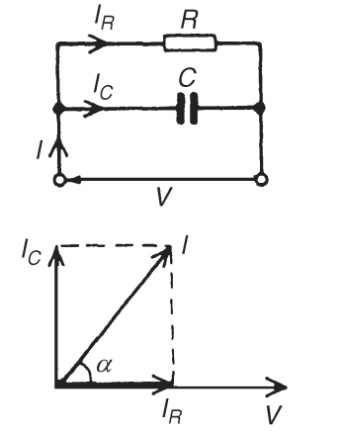
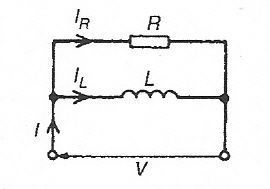

Fig. 41. Parallel AC circuits: RL and RC.
For any parallel AC circuit:
True or active power, P = VI cosφ watts (W)
or P = (IR)2R watts
Apparent power, S = VI voltamperes (VA)
Reactive power, Q = VI sinφ reactive voltamperes (var)
true power
Power factor = -------------------- = P/S = cosφ
apparent power
These formulae are the same as for series AC circuits as used before.
LR – C parallel AC circuit
In the two branch circuit containing capacitance C in parallel with inductance L and resistance R in series (such as a coil) shown in Figure 42 (a), the phasor diagram for the LR branch alone is shown in Figure 42 (b) and the phasor diagram for the C branch is shown alone in Figure 42 (c). Rotating each and superimposing on one another gives the complete phasor diagram shown in Figure 42 (d). The current ILR of Figure 42 (d) may be resolved into horizontal and vertical components.
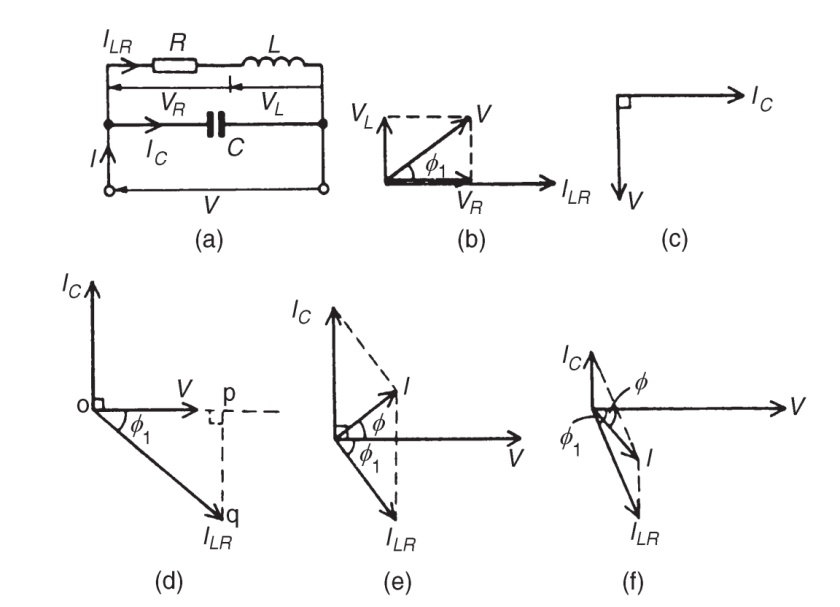
Fig. 42. RLC parallel circuit.
The horizontal component, shown as op is ILRcosφ1 and the vertical component, shown as pq is ILRsinφ1. There are three possible conditions for this circuit:
IC > ILRsinφ1 (giving a supply current I leading V by angle
φ — as shown in Figure 42 (e))
ILRsinφ1>IC (giving I lagging V by angle φ—as shown in Figure 42 (f))
IC = ILRsinφ1 (this is called parallel resonance).
There are two methods of finding the phasor sum of currents ILR and IC in Figures 42 (e) and (f). These are: (i) by a scaled phasor diagram, or (ii) by resolving each current into their ‘in-phase’ (i.e. horizontal) and ‘quadrature’ (i.e. vertical) components.
With reference to the phasor diagrams of Figure 42:
Impedance of LR branch, ZLR = √(R2 + XL2)
to resolve in-phase component quadrature component to superimpose phasor reference phasor |
розділяти фазова компонента квадратична компонента накладати фазор (вектор) відносний фазор |
What is parallel resonance?
Why is R component is taken into account only in L brunch of the circuit?
What stands for quadrature component?
How is it possible to calculate the total effective current value through the circuit in Figure 42?
Exercise 2. Explain the terms with other words.
Phasor diagram.
In-phase component.
Impedance.
Horizontal and vertical vector components.
Active, reactive and apparent power.
Power factor.
Superimposing.
Exercise 3. Find out in the text synonyms for the following terms.
Standard vector, vector diagram, effective resistance, to overlay, the part being found with quadratic formula, upright constituent, to move behind, whole.
Граматичні відомості
Умовні речення. Реальні умови (zero and first conditional)
Підрядна частина умовного речення містить умову, за якою виконується дія головного речення. Найбільш поширеним сполучником для таких речень є if (якщо). В залежності від того, наскільки здійсненна умова, структура речень цього типу суттєво різниться. Умова речення так званого ‘нульового’ типу (‘zero’ conditional) зазвичай стосується будь-якого часу, тобто у цьому випадку if означає when або whenever (коли або будь-коли). Вони описують ситуацію, яка завжди відбувається за наявності певних передумов:
If I don’t understand the meaning of the word, I look it up in the dictionary.
Як і в усіх умовних реченнях, кома ставиться, тільки якщо підрядне речення стоїть перед головним:
They say police officers walk the beat if they walk around an area of a town or city in order to make sure nobody is committing a crime.
If you leave after 6:00, you hit all the rush hour traffic.
Речення, що починаються з if, можуть також використовуватись для описання звичайних ситуацій або звичок у минулому. У таких випадках в обох частинах складного речення використовується форма минулого часу Past Indefinite:
If we were on vacation near the sea, we swam every day.
Для описування звичних ситуацій у минулому у головному реченні також часто вживаються фразеологічні сполучення з ‘would’ або ‘used to’:
If we worked in the same office, we would often have coffee together.
If the weather was fine, we used to walk in the park.
Реальні умови, що стосуються майбутнього часу, зазвичай позначаються в англійській граматиці, як умови першого типу (first conditional). Як умова, так і наслідок – цілком реальні. Структура речення аналогічна розглянутій у випадку умовних речень часу: у підрядній частині речення використовується теперішній час замість майбутнього:
We'll stay at home if it rains.
If the scanned characteristic does not match any stored template, the system will reject the person.
You won’t pass the exams if you don’t work hard.
If there isn’t a bus, how will he get home?
Якщо є потреба підкреслити завершеність дії, у підрядній частині (після if) використовується перфектна форма дієслова Present Perfect:
If he’s read the book, he’ll land it to you.
Інколи до дієслова у підрядному реченні додається модальне дієслово should:
If I should see Peter tonight, we’ll discuss our plans for the nearest weekend.
Will you bring me an umbrella if it should rain?
У цьому випадку висловлення стає менш здійсненним, тобто ймовірність здійснення умови зменшується. Зміст першого з наведених, як приклад, речень можна передати таким чином:
Якщо я раптом побачу Пітера ввечері, ми обговоримо наші плани на найближчі вихідні.
Майбутній час у головному реченні може бути переданий будь-яким способом, прийнятим в англійській мові (наказовий спосіб, інфінітив, модальне дієслово та ін.):
Give him my phone number if you should meet him.
I want you to help me if you are not busy tonight.
Are you going to the party if you are invited?
If you need money next week, I can lend you some.
Наведені нижче приклади ілюструють можливості використання речень з реальними умовами в різних функціях. Кожен з цих прикладів описує можливу умову та ймовірний результат:
I can help you if you like (offer).
If you leave me, I’ll die (threat).
If you touch this wire, you’ll be hurt (warning).
If I have received your address, I’ll send you back all the materials (promise).
Exercise 1. Complete the sentences with the verbs in parentheses. Add modal verbs if need be.
Have you seen my book? No, but if I (find) _______ it, I (give) _______ it to you.
If I should find your book, I (call) _________ you tonight.
I’ll make a delicious salad if the tomatoes in my garden (be) ______ ripe.
If the temperature is 100 °C, water (boil) ________.
Please ask him to call me if he (be) _______ at home tomorrow.
Exercise 1. Work with your classmate or in a small group. Find out about a classmate’s habits nowadays and in the past. Follow examples:
What do you do if it rains at weekend? - If it rains, I don’t go out and do my chores or watch TV.
When you were younger, what did you do if you had free time? - In summer if I had free time after classes I used to play football with my friends.
What do you do if you…
have free time?
are going to miss the train?
run into your old friend whom you have not seen for years?
have a terrible headache?
Ask your own questions.
Exercise 2. Complete the sentences with appropriate endings.
I’ll meet you tomorrow if …
Please, if you should find this, …
If he’s already come, …
I’m going to watch this movie if …
It’s been a long drought. A lot of crops will die if …
Exercise 3. Now ask a number of questions about someone’s habits in the past following the examples given before.
Комунікативна практика
Пропозиція допомоги. Згода та відмова
Пропонуючи допомогу, звертайтесь до співбесідника з ввічливим питанням (прямим або опосередкованим):
Can I help you?
Can I help you with that?
Would you like me to get it for you?
Do you think you can manage this on your own?
If you want, I could get it for you.
Any point in my getting it for you?
How about me getting it for you?
Is there anything I can do for you?
What seems to be the trouble?
Звичайно, форма питання залежить від ступеня знайомства, віку співбесідників та інших обставин. Будьте обережні, інколи занадто ввічлива фраза може бути сприйнята як іронічна або навіть саркастична.
Ваша пропозиція може бути сприйнята або відхилена. Форма відповіді знов-таки суттєво залежить від вищезазначених факторів:
Thanks.
Thanks a lot.
Oh, would you? Thanks.
That’s nice of you, thanks.
Thank you, kind sir.
No, don’t bother, I can do it myself.
Thanks a lot, but I’m OK.
You could if I needed something.
Exercise 1. Work with your classmate. Offer some help: to pass something, to find out direction, to get acquainted with something, etc.
Exercise 2. Listen to partner’s problems (terrible headache, homework isn’t done, watch has stopped, etc.). Offer your assistance.
Вправи для самостійної роботи
Exercise 1. Translate the text from pages 266-268 (Exercise 1) into Ukrainian (Russian).
Exercise 2. Complete the sentences.
Now that I finally finished …
Our investigation did not … because …
Since this approach requires too expensive equipment …
I cannot give you an answer right now because …
Since we have a holiday tomorrow …
Lesson 6
ВИВЧЕННЯ ТЕРМІНОЛОГІЇ ЗА ТЕМОЮ МОДУЛЯ
Exercise 1. Learn the following text and then answer the questions.
Transformations of ac
A transformer is a device which uses the phenomenon of mutual induction to change the values of alternating voltages and currents. In fact, one of the main advantages of AC transmission and distribution is the ease with which an alternating voltage can be increased or decreased by transformers. Losses in transformers are generally low and thus efficiency is high. Being static they have a long life and are very stable. Transformers range in size from the miniature units used in electronic applications to the large power transformers used in power stations. The principle of operation is the same for each. A transformer is represented in Figure 43a as consisting of two electrical circuits linked by a common ferromagnetic core. One coil is termed the primary winding which is connected to the supply of electricity, and the other the secondary winding, which may be connected to a load. A circuit diagram symbol for a transformer is shown in Figure 43 (b).
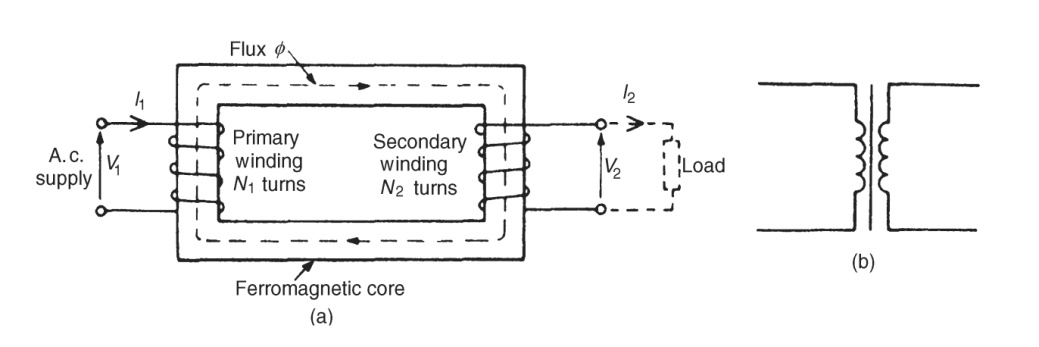 Fig.
43. A transformer.
Fig.
43. A transformer.
Principle of operation. When the secondary is an open-circuit and an alternating voltage is applied to the primary winding, a small current—called the no-load current I0—flows, which sets up a magnetic flux in the core. This alternating flux links with both primary and secondary coils and induces in them e.m.f.’s of E1 and E2 respectively by mutual induction.
The induced e.m.f. E in a coil of N turns is given by
![]() volts,
volts,
where
![]() is the rate of change of flux. In an ideal transformer, the rate of
change of flux is the same for both primary and secondary and thus
is the rate of change of flux. In an ideal transformer, the rate of
change of flux is the same for both primary and secondary and thus![]() ,
i.e. the induced e.m.f. per turn is constant.
,
i.e. the induced e.m.f. per turn is constant.
Assuming no losses, E1 = V1 and E2 = V2. Hence
![]() or
or
![]() (1)
(1)
![]() is
called the voltage ratio and
is
called the voltage ratio and
![]() the
turns ratio, or the ‘transformation
ratio’
of the transformer. If N2
is less than N1
then V2
is less than V1
and the device is termed a step-down
transformer. If N2
is greater than N1
then V2
is greater than V1
and the device is termed a step-up
transformer.
the
turns ratio, or the ‘transformation
ratio’
of the transformer. If N2
is less than N1
then V2
is less than V1
and the device is termed a step-down
transformer. If N2
is greater than N1
then V2
is greater than V1
and the device is termed a step-up
transformer.
When a load is connected across the secondary winding, a current I2 flows. In an ideal transformer losses are neglected and a transformer is considered to be 100% efficient.
Hence input power = output power, or V1I1 = V2I2, i.e., in an ideal transformer, the primary and secondary volt-amperes are equal.
Thus
![]() (2)
(2)
Combining equations (1) and (2) gives:
![]()
The rating of a transformer is stated in terms of the volt-amperes that it can transform without overheating. With reference to Figure 43 (a), the transformer rating is either V1I1 or V2I2, where I2 is the full-load secondary current.
-
ferromagnetic core
primary/secondary winding
turn
transformation ratio
step-up/-down
overheating
full load
феромагнітний сердечник
первинна/вторинна обмотка
тут: виток
коефіцієнт трансформації
підвищувальний/понижуючий
перегрів
повне навантаження
What is a transformer?
How does it work?
Is it possible to use a step-down transformer as a step-up one? If it is possible, what limitations may exist?
What is an ideal transformer? How is it different from a real one?
What are ways to prevent overheating of a transformer?
Exercise 2. Translate the following terms into English referring to the text.
Вольт-амперна характеристика, вихідна потужність, змінний потік, коефіцієнт корисної дії, індукована е.р.с., сердечник трансформатора, холостий струм.
Exercise 3. Complete the sentences with appropriate endings.
If the number of terns in the primary coil of a transformer exceeds the number in secondary one, …
Losses in transformers are …
Transformers have usually long life because …
A transformer that increases original voltage is called …
The transformer status is expressed in …
Граматичні відомості
Умовні речення першого типу зі сполучниками in case, unless, except if, even if, provided
В умовних реченнях першого типу в ролі сполучників, що з’єднують частини речення, крім if, можуть використовуватись і деякі інші слова.
Наприклад, сполучення іn case (that) and in the event (that) вказують, що зазначена подія скоріше за все не відбудеться, хоча така можливість повністю не виключена:
Take an umbrella, in case it should rain.
You can return your purchase in case you are not satisfied with it.
Mark your backpack in case you lose it.
Інколи за in case може стояти дієслово у формі минулого часу, якщо дія у головному реченні стосується минулих подій:
We bought a lot of food and drinks yesterday in case our friends came. – It means that friends were going to come yesterday.
Сполучник unless означає except if або if … not, тобто за винятком або якщо тільки не.
You can’t watch this movie unless you are 16. = You can’t watch this movie if you are not 16.
You are going to fail your test unless you work harder.
Фрази provided (providing) або but only if позначають, що є визначені умови, які спричиняють певний результат:
We don’t miss the train providing we hurry.
You can borrow my notebook, provided I have it back by six o'clock.
Речення з even if передають думку, що зазначена умова не має значення, тому що результат все одно не зміниться. Зазвичай після цієї фрази йде неочікуваний наслідок:
She's going to have problems finding a job even if she gets her A levels.
Exercise 1. Paraphrase the sentences using unless (except if).
You can’t travel oversees if you don’t have a passport.
Our company will close if some extra money isn’t found.
I won’t go asleep if you don’t tell me a story.
I can buy a car only if I save enough money.
I’m afraid the battery is dead. I won’t run my laptop only if I recharge it.
We must hurry or we’ll miss a bus.
He must apologize to me or I’ll leave him.
This program is very convenient only if you know how to use it.
Exercise 2. Complete the sentences with appropriate conjunction. Add a comma if necessary.
You’d better take your raincoat with you _______ the weather changes.
I’m going to the park __________ it rains.
________ you need to get in touch with me I’ll leave my home number.
Sam will graduate _______ he passes all of his courses.
I’ll get tickets _________ there are still some.
__________ you practice every day you won’t learn to speak English well.
Комунікативна практика
Talking about the weather
The weather as well as environment are considered the most common and neutral topics while talking with strangers. You can use such subjects to start a conversation.
Exercise. Listen to the conversation and then engage your classmate in short conversation about the weather.
A: Hello, it’s a beautiful day, isn’t it?
B: Not bad. It’s a little cold.
A: Oh, I like that. I like cold weather.
B: I don’t like summer. It’s too hot. Don’t you like cold weather?
A: No, not very much. Do you come here in winter?
B: I like the park in winter.
A: Why?
B: It’s so clean. There aren’t any leaves. There aren’t many people.
A: Winter is the best time in the park.
B: Do you like snow?
A: I like a little snow. My friend likes snow.
B: Why do you like the park in the snow?
A: I like the trees in winter. I like the hills – you can see very far. Do you come here in winter?
B: No, I don’t live nearby. It’s too far for me.
A: Well, enjoy your day.
B: Yes, but it looks like rain. Do you think it will rain?
A: I don’t know, I can’t tell. I hope it doesn’t rain today. We are going to a fountain now.
B: It’s very nice. Have a good day.
A: Thanks.
nice (terrible, horrible) weather
cold (cool, hot) day
scorching heat, scorcher, a scorcher of a day = very hot day
shower of rain, to be pouring with rain
Вправи для самостійної роботи
Exercise 1. Translate the text from pages 273-275 into Ukrainian (Russian).
Exercise 2. Complete the sentences using your own words.
Example. He can't leave her unless …(…he knows she's all right.)
I’ll go to the party only if …
I never work at the weekend unless…
Providing that all our work is completed …
Exercise 3. Complete the sentences below with the words from the box.
Programs fall into two major classes: ___________ programs and __________ systems.
______________ is used in artificial intelligence research and to perform such tasks as machine translation, process control, handwriting recognition, and weather forecasting.
Ceramic metal-oxide compounds containing rare earth elements were found to be _____________ at temperatures high enough to permit using liquid nitrogen as a coolant.
Dialog between the ________ and the computer is usually accomplished by command-line or graphical ________ interfaces (GUIs).
News reporters can compose news stories on portable PCs, called _________, and electronically submit these stories from remote locations.
computers, superconductors, application, users, operating, user, laptop |
Lesson 7
ВИВЧЕННЯ ТЕРМІНОЛОГІЇ ЗА ТЕМОЮ МОДУЛЯ
Exercise 1. Learn the text and then answer the questions.
Ac rectification
The process of obtaining unidirectional currents and voltages from alternating currents and voltages is called rectification. Automatic switching in circuits is carried out by devices called diodes. Using a single diode, as shown in Figure 44, half-wave rectification is obtained. When P is sufficiently positive with respect to Q, diode D is switched on and current i flows. When P is negative with respect to Q, diode D is switched off. Transformer T isolates the equipment from direct connection with the mains supply and enables the main’s voltage to be changed. Two diodes may be used as shown in Figure 45 to obtain full wave rectification. A centre-tapped transformer T is used. When P is sufficiently positive with respect to Q, diode D1 conducts and current flows (shown by the broken line in Figure 45). When S is positive with respect to Q, diode D2 conducts and current flows (shown by the continuous line in Figure 45). The current flowing in R is in the same direction for both half cycles of the input. The output waveform is thus as shown in Figure 45.
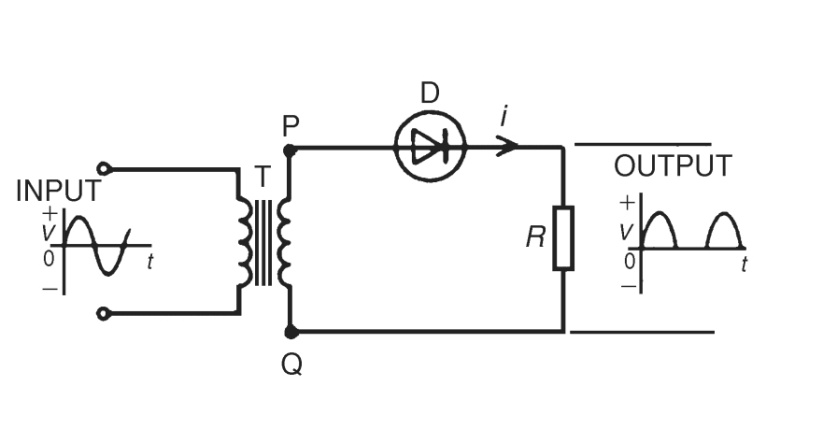
Fig. 44. Half-wave rectification.
Four diodes may be used in a bridge rectifier circuit, as shown in Figure 46 to obtain full wave rectification. As for the rectifier shown in Figure 45, the current flowing in R is in the same direction for both half cycles of the input giving the output waveform shown.
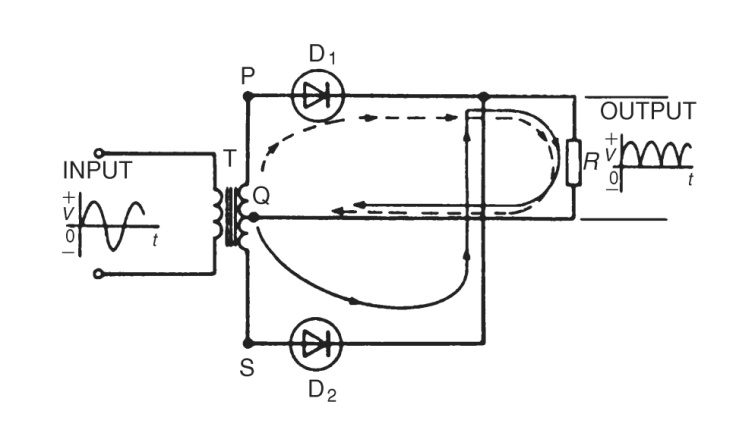
Fig. 45. Two diode rectifier.
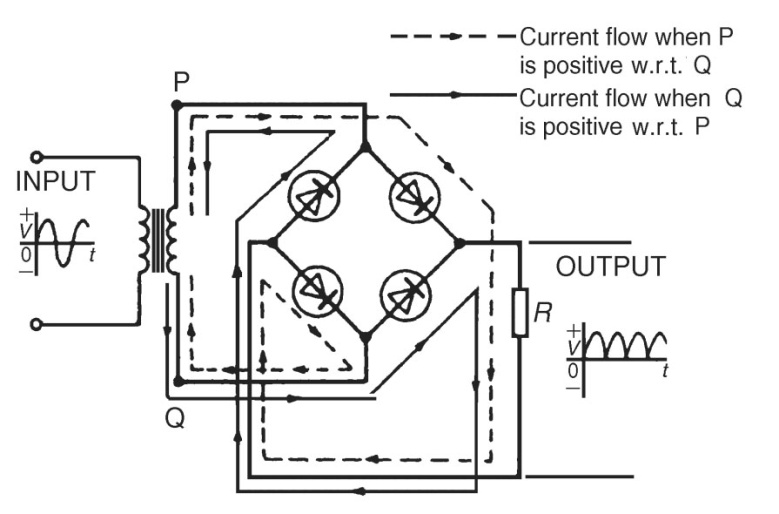
Fig. 46. Full wave rectifier.
To smooth the output of the rectifiers described above, capacitors having a large capacitance may be connected across the load resistor R.
-
main
centre-tapped
half-wave
sufficiently
rectifier
to smooth
електрична мережа, магістраль
з відводом від середини котушки
півхвильовий
значно
випрямляч
згладити
When rectifiers are used?
How does a rectifier work?
How many diodes is needed to get full wave rectifications?
Is it possible to covert ac into smooth direct current without any pulses?
What functions in a rectifier circuit does a transformer perform?
Exercise 2. Fill in the gaps in the sentences with appropriate words from the text.
A rectifier is an electrical device that converts _________ current, which periodically reverses direction, to ________ current, which is in only one direction, a process known as ___________. ____________ have many uses including as components of power supplies and as detectors of radio signals.
A half-__________ rectifier will only give one peak per _______ and for this and other reasons is only used in very small power supplies. A _____ ______ rectifier achieves two peaks per _____ and this is the best that can be done with single-phase input.
In order to produce steady DC from a rectified AC supply, a ___________ circuit or filter is required.
Exercise 3. Make word combinations using the words from the columns and translate them into Ukrainian (Russian).
-
unidirectional
automatic
output
bridge
half-wave
direct
centre-tapped
load
rectifier
resistor
switching
waveform
rectification
transformer
connection current
